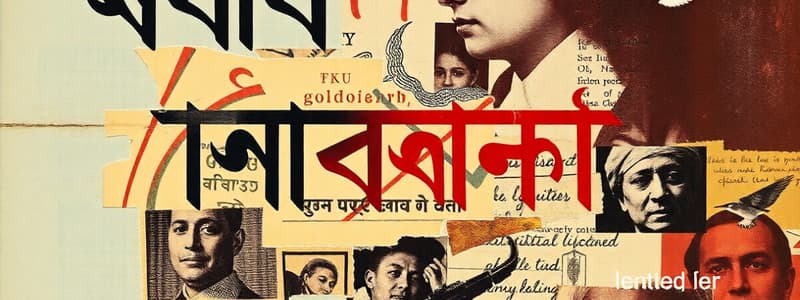Podcast
Questions and Answers
The Bengali script is a consonant-based abugida, meaning it uses diacritics on consonants to form syllables.
The Bengali script is a consonant-based abugida, meaning it uses diacritics on consonants to form syllables.
True (A)
The Bengali script is directly derived from the Devanagari script, which is used for Hindi and Nepali.
The Bengali script is directly derived from the Devanagari script, which is used for Hindi and Nepali.
False (B)
Bengali grammar is considered highly inflected, meaning words change form depending on their function in a sentence.
Bengali grammar is considered highly inflected, meaning words change form depending on their function in a sentence.
True (A)
Bengali grammar strictly adheres to a rigid system of grammatical gender, similar to other languages like French or Spanish.
Bengali grammar strictly adheres to a rigid system of grammatical gender, similar to other languages like French or Spanish.
The word order of Bengali is predominantly Subject-Verb-Object (SVO), which is also common in English.
The word order of Bengali is predominantly Subject-Verb-Object (SVO), which is also common in English.
Bengali pronunciation relies heavily on complex tone patterns and stress variations, similar to languages like Mandarin.
Bengali pronunciation relies heavily on complex tone patterns and stress variations, similar to languages like Mandarin.
Bengali literature has a rich history, featuring prominent figures like Rabindranath Tagore, a Nobel laureate in literature.
Bengali literature has a rich history, featuring prominent figures like Rabindranath Tagore, a Nobel laureate in literature.
The prevalence of dialects in Bengali is minimal, with most speakers understanding each other without difficulty.
The prevalence of dialects in Bengali is minimal, with most speakers understanding each other without difficulty.
Flashcards
Bengali Language
Bengali Language
An Indo-Aryan language mainly spoken in Bangladesh and parts of India.
Bengali Script
Bengali Script
An abugida script used for writing Bengali, featuring consonant-vowel combinations and diacritics.
Phonology of Bengali
Phonology of Bengali
A phonological system that includes approximants, fricatives, stops, and nasals; tones are less significant.
Grammatical Structure
Grammatical Structure
Signup and view all the flashcards
Dialects of Bengali
Dialects of Bengali
Signup and view all the flashcards
Bengali Literature
Bengali Literature
Signup and view all the flashcards
Rabindranath Tagore
Rabindranath Tagore
Signup and view all the flashcards
Inflection in Bengali
Inflection in Bengali
Signup and view all the flashcards
Study Notes
Bengali Language Overview
- Bengali is an Indo-Aryan language spoken primarily in Bangladesh and the Indian states of West Bengal, Tripura, and Assam.
- It's the official language of Bangladesh and one of the official languages of India.
- It has a rich literary tradition, with a significant history of poetry, prose, and drama.
- Bengali is written using the Bengali script, derived from the Brahmic script family.
Bengali Script
- The Bengali script is an abugida, meaning it has consonant-vowel combinations.
- It's distinct from the Devanagari script used for Hindi and Nepali.
- Vowels are shown as diacritics that are added to consonant letters to create syllables.
- The script is predominantly used for Bengali, although other languages like Assamese, Odia, and Sylheti are also written with modifications of the Bengali script.
- It utilizes ligatures, combining forms of letters for better visual and stylistic effect.
Phonology
- Bengali has a relatively simple phonological system compared to some other languages.
- The consonant inventory consists of approximants, fricatives, stops, and nasals, which combined with vowel sounds, forms a comprehensive range of pronunciation.
- Tones and stress patterns are generally not as significant as in other languages.
Grammar
- Bengali is a highly inflected language, meaning words change their forms depending on their usage and function in a sentence.
- Grammatical gender, although existing, is less rigorously structured than other languages.
- The language's word order is predominantly Subject-Object-Verb (SOV).
- There are grammatical cases and aspects that affect the word forms in sentences.
- Noun declensions and verb conjugations are part of the sentence structure, showing how words relate to each other based on their roles in the sentence.
Dialects
- Many dialects of Bengali exist, varying regionally in vocabulary, pronunciation, and grammar.
- Some dialects show noticeable differences, and understanding them might require regional focus.
Literary Traditions
- A rich literary heritage exists, with prominent figures and works spanning centuries.
- The language played crucial roles in the social and political development of the region.
- There's a strong presence of both classical and modern literature, encompassing a broad range of topics from love and mysticism to social critique.
- Rabindranath Tagore, a Nobel laureate, is one of the most celebrated figures in Bengali literature. His works also encompass different genres and are a significant contribution.
Importance and Modern Use
- Bengali is an important language for intercultural exchange.
- It plays a crucial role in the cultural life of the region.
- Modern use of Bengali encompasses various aspects, including newspapers, films, music, and social media interactions.
Modern Usage and Role
- The language is used extensively in media, from films and television to newspapers and magazines.
- It has a strong presence in the arts and culture scene in both Bangladesh and India.
- The language plays a vital part in the education systems of the region, and continues to evolve in modern contexts.
Studying That Suits You
Use AI to generate personalized quizzes and flashcards to suit your learning preferences.




